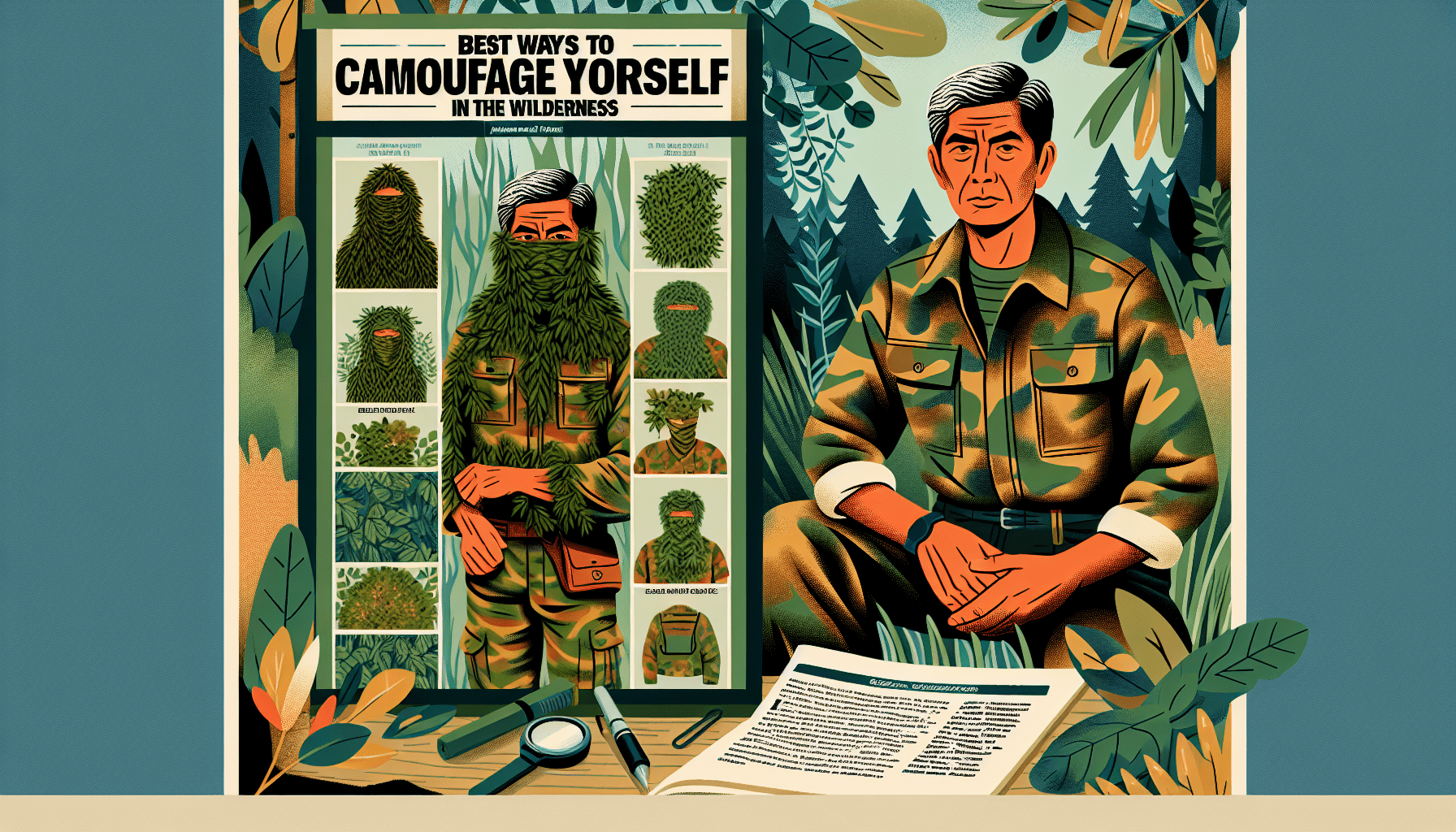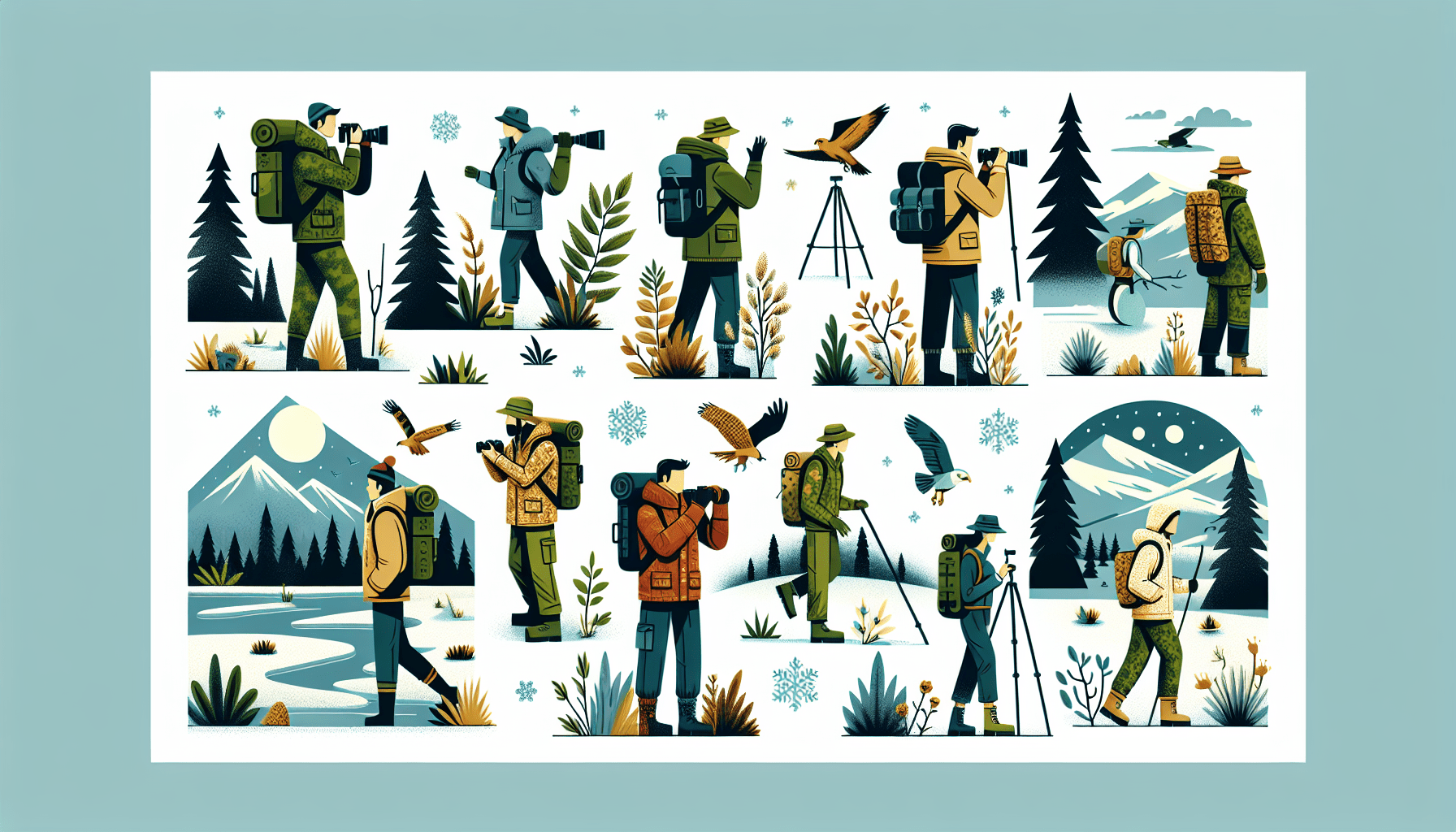Imagine venturing out into the wild, surrounded by nature’s beauty and tranquility. As you immerse yourself in the untamed wilderness, one thought crosses your mind: how can I blend in seamlessly with my surroundings? Fear not, fellow adventurer, for we have gathered the best ways to camouflage yourself in the wilderness. Whether you are an avid hunter, a wildlife enthusiast, or simply seeking to appreciate nature up close, these expert tips will ensure you become one with the wilderness, allowing you to observe its inhabitants undisturbed.
Choose the Right Colors
Understand the Environment
When it comes to camouflage, understanding the environment you will be venturing into is crucial. Take the time to study the colors and tones of the area. Is it a lush forest with vibrant greens and browns, or a dry desert with sandy hues? By observing and understanding the predominant colors of your surroundings, you can select camouflage that blends seamlessly into the natural landscape.
Use Earth Tone Colors
Earth tone colors, inspired by nature itself, are excellent choices for blending in with the wilderness. Shades of brown, green, and tan mimic the colors found in the environment and help to break up your silhouette. Whether you choose camouflage apparel or face paint, opting for earthy colors will make you less noticeable to both humans and animals.
Avoid Bright Hues
Vibrant and bright colors are the opposite of what you want when trying to camouflage yourself. Neons and bold tones will only draw attention to your presence. Stay away from anything that stands out like a sore thumb, such as bright reds or blues. Instead, stick to muted, natural tones that will aid in your concealment.
Blend with Natural Surroundings
Choose Patterns That Match the Terrain
Matching the patterns of your camouflage to the terrain can greatly enhance your ability to blend in. Look for camouflage patterns that mimic the textures and shapes of the environment you will be in. Whether it’s a woodland pattern for the forest or a desert pattern for arid landscapes, selecting the right pattern will make you virtually invisible.
Use Natural Materials for Camouflage
Utilizing natural materials can be an effective way to blend in with your surroundings. Branches, leaves, and even mud can be strategically placed on or around your body to disrupt your outline and create a more organic appearance. By incorporating elements from the environment, you can increase your chances of going unnoticed.
Break the Human Silhouette
One of the key goals of camouflage is to break up the human silhouette, making it harder for others to spot you. By using natural elements to create irregular shapes and shadows, you can effectively camouflage yourself. Incorporate tree branches into your clothing or attach them to your ghillie suit to blend seamlessly with the environment.

Master Proper Face and Body Camouflage
Apply Face Paint to Break Up Features
Your face is one of the most distinguishable features, especially when it comes to camouflage. Applying face paint can help break up the recognizable contours and lines, making it harder for others to identify you. Use earth tone colors and paint in a way that mimics natural shadows and highlights, ensuring your face blends in seamlessly with the surroundings.
Use Natural Materials to Create Texture
Creating texture with natural materials can be highly effective in camouflaging your body. Incorporate items like grass, moss, or small branches into your clothing or attach them to your ghillie suit. The additional texture will help break up your outline and make you appear more like a part of the environment.
Follow the Contours of the Face and Body
When applying camouflage to your face and body, it’s essential to follow the contours and lines of your features. By working with the natural curves and angles of your face and body, you can create a more realistic camouflage. Take the time to blend the colors and textures in a way that seamlessly integrates with your natural shape.
Minimize Sound and Movement
Stay Still and Move Slowly
One of the biggest giveaways in the wilderness is sudden, jerky movements. To avoid being detected, it’s important to stay still and move slowly. Take the time to observe your surroundings and plan your movements accordingly. By being deliberate and cautious, you can minimize noise and maintain your camouflage.
Avoid Stepping on Dry Leaves or Twigs
Stepping on dry leaves or twigs can create a loud noise that alerts others to your presence. Whenever possible, avoid walking directly on these crunchy surfaces. Instead, look for areas with softer ground cover or use alternative methods of movement, such as stepping on rocks or fallen logs, to prevent unnecessary noise.
Use Noise Dampening Techniques
In addition to being mindful of your movements, there are techniques you can employ to minimize noise. Layering your clothing can help muffle any rustling sounds, as can using fabric with a soft texture. Additionally, attaching natural materials to your gear, such as leaves or bits of moss, can help dampen any noise caused by equipment or accessories.

Use Natural Odor-Masking Techniques
Avoid Strong-Scented Products
Strong scents, whether from perfumes, soaps, or other personal care products, can be easily detected by animals in the wilderness. To avoid giving your presence away, steer clear of anything with a strong smell. Opt for unscented or lightly scented products instead to further enhance your camouflage.
Blend in with Natural Scents
To truly camouflage yourself in the wilderness, it’s important to blend in with the natural scents of the environment. Avoid using scented deodorants, shampoos, or other products that may mask your natural odor. By embracing your body’s natural scent, you can avoid standing out and alarming nearby creatures.
Use Earthy Scents for Disguise
If you want to take your odor-masking techniques a step further, consider using earthy scents to further disguise your presence. Natural scents such as pine, dirt, or wood can help you blend in with the surrounding environment. Utilize natural materials with these scents or apply essential oils sparingly to your body or gear.
Utilize Natural Camouflage Techniques
Examine Animal Camouflage Strategies
Animals have evolved exceptional camouflage techniques throughout the ages. Take the time to study and learn from their strategies. Look for animals with a similar habitat and observe how they blend into their environment. By understanding their techniques, you can apply them to your own camouflage methods.
Use Natural Materials as Coverings
Nature provides a multitude of materials that can be used for camouflage. By utilizing items such as branches, leaves, twigs, or grass, you can create effective coverings to break up your silhouette. Attach these natural materials to your gear or clothing to seamlessly blend in with your surroundings.
Learn from Nature’s Masters of Disguise
Mother Nature has her own experts in the art of camouflage. Creatures like chameleons, octopuses, and certain insects have mastered the skill of disappearing into their surroundings. Observe and learn from their techniques, such as blending with colors or adjusting skin texture, to enhance your own camouflage abilities.
Choose Suitable Camouflage Gear and Clothing
Invest in High-Quality Camouflage Apparel
Investing in high-quality camouflage apparel can make all the difference in your ability to blend into the wilderness. Look for garments that are specifically designed for the environment you will be in, such as forest or desert camo. Choose durable materials that won’t snag or tear easily, allowing you to move stealthily through the wilderness.
Consider Seasonal Camouflage Patterns
Different seasons bring different colors and textures to the wilderness. Consider selecting camouflage patterns that align with the season you’ll be spending time outdoors. Opting for patterns that match the changing foliage or the snowy landscape will ensure your camouflage remains effective year-round.
Opt for Lightweight and Breathable Fabrics
Comfort is key when it comes to camouflage gear and clothing. Ensure that the fabrics you choose are lightweight and breathable, allowing you to move freely without becoming overheated or sweaty. Moisture-wicking materials can also be beneficial, as they help keep you dry and comfortable during physically demanding activities.
Employ Effective Camouflage Techniques
Break the Human Shape with Ghillie Suits
Ghillie suits are excellent tools for breaking up the human shape and blending in with the wilderness. These suits feature strips of fabric or netting to which natural materials can be attached. By adding elements like leaves, twigs, and moss, you can create a three-dimensional disguise that allows you to blend seamlessly with your surroundings.
Conceal Yourself with Natural Elements
Nature offers an abundance of natural elements that can be used to conceal yourself. Applying mud or dirt to your clothing or gear can help to further break up your silhouette and provide an added layer of camouflage. Utilize natural coverings such as tree branches, rocks, or fallen logs to create hiding spots that allow you to remain undetected.
Create False Shadows and Depth
Using shadows and depth to your advantage can significantly enhance your camouflage. By strategically placing natural materials like branches or rocks to cast shadows or create the illusion of depth, you can further disguise your presence. This technique can be particularly effective when trying to blend into rocky or uneven terrains.
Understand Light and Shadow
Blend with the Lighting Conditions
Lighting conditions in the wilderness can vary greatly throughout the day. Pay attention to the changing light and adjust your camouflage as needed. For example, during sunrise or sunset when the light is softer and warmer, using warmer tones in your camouflage can help you blend in seamlessly. Similarly, during midday when shadows are harsher, opt for colors that match the brighter surroundings.
Avoid Creating Unnatural Shadows
While shadows can be utilized as part of your camouflage, it’s important to avoid creating unnatural shadows that may expose your presence. Be mindful of your positioning and any objects that may cast conspicuous shadows. Ensuring that your silhouette remains inconspicuous is crucial for maintaining effective camouflage.
Use Shadows to Your Advantage
When used strategically, shadows can aid in your camouflage. Positioning yourself in areas where shadows naturally occur, such as under trees or behind rocks, can help break up your outline and make you less noticeable. Observing the direction and intensity of the light can enable you to position yourself in areas where shadows will work in your favor.
Practice Stealthy Movement and Observation
Move Slowly and Cautiously
Moving slowly and cautiously is key to remaining undetected in the wilderness. Take your time with each step and be mindful of any noise you may make. By moving deliberately and quietly, you increase your chances of staying hidden and surprising potential threats or prey.
Use Obstacles for Cover
When navigating through the wilderness, make use of natural obstacles for cover. Trees, bushes, or boulders can provide valuable hiding spots that break up your silhouette. As you move, observe your surroundings and plan your route to make the most of these opportunities for concealment.
Develop a Keen Eye for Detail
Having a keen eye for detail is crucial when it comes to camouflage. Train yourself to notice even the smallest changes in your surroundings. By identifying patterns, textures, and colors, you can better blend in with your environment. The more attention you pay to detail, the more effective your camouflage will be.
In conclusion, mastering the art of camouflage in the wilderness requires a combination of knowledge, practice, and careful attention to detail. By choosing the right colors, blending with natural surroundings, applying proper face and body camouflage, minimizing sound and movement, utilizing natural odor-masking techniques, and employing effective camouflage techniques, you can increase your chances of blending seamlessly into the wilderness. Remember to choose suitable camouflage gear and clothing, understand light and shadow, and practice stealthy movement and observation. With these tips, you’ll be well on your way to becoming a master of wilderness camouflage.
